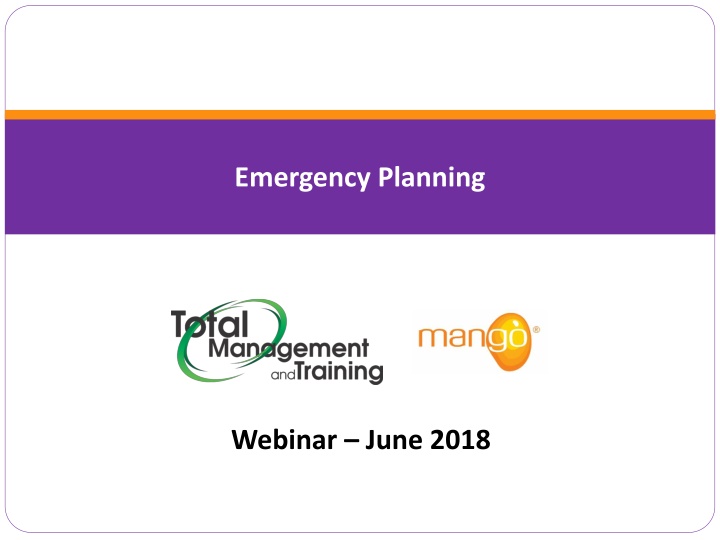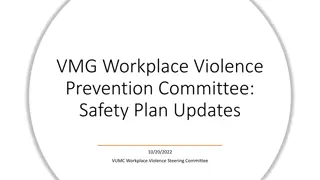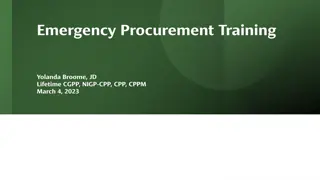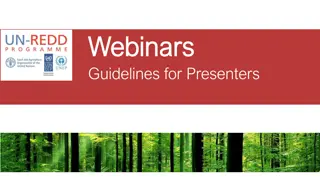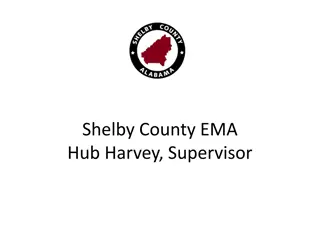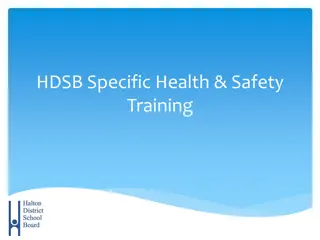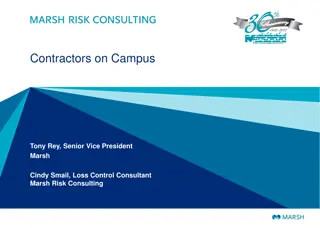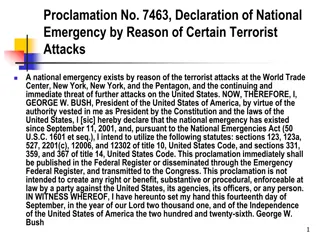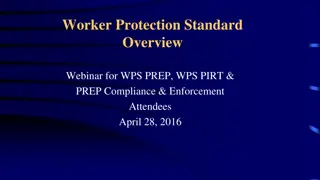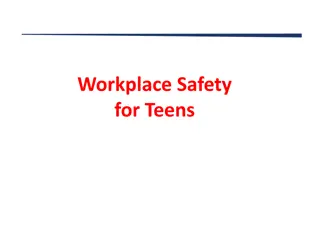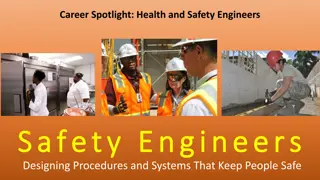Comprehensive Emergency Planning Webinar for Workplace Safety Compliance
Total Management and Training offers consultancy and training services in emergency planning and workplace safety compliance. The webinar in June 2018 highlighted essential aspects of emergency planning, including WHS legislation requirements, effective response procedures, and communication strategies. Presenters Craig Thornton and Laurie O'Donoghue shared valuable insights based on their expertise in the field. Learn how to develop and implement emergency plans to ensure a safe work environment.
Download Presentation

Please find below an Image/Link to download the presentation.
The content on the website is provided AS IS for your information and personal use only. It may not be sold, licensed, or shared on other websites without obtaining consent from the author.If you encounter any issues during the download, it is possible that the publisher has removed the file from their server.
You are allowed to download the files provided on this website for personal or commercial use, subject to the condition that they are used lawfully. All files are the property of their respective owners.
The content on the website is provided AS IS for your information and personal use only. It may not be sold, licensed, or shared on other websites without obtaining consent from the author.
E N D
Presentation Transcript
Emergency Planning Webinar June 2018
Presenters Craig Thornton Chief Marketing Officer, Mango Limited craig@mangolive.com New Zealand +64 29 377 5444 @mangolimited LinkedIn Blog www.mangolive.com
Presenters Laurie O Donoghue Managing Director - Total Management and Training laurie@totalmantra.com.au Australia +61 427 100 454 www.totalmantra.com.au
Who are we? Total Management and Training is a management consultancy and registered training organisation based in Cairns, Australia offering consultancy, nationally accredited courses and competencies across a range of industries. TMT has a reputation of providing prompt, professional service, using qualified, experienced consultants and trainers to deliver up-to-date, industry standard training and advice. Qualifications in Work Health and Safety Qualifications in Business Qualifications in Training and Assessment Work Health and Safety Representative training Fire and Emergency Training General Health and Safety Training in including courses in confined space entry, working at heights, asbestos removal, test and tag, emergency warden, construction induction and many others. Health and safety general consulting Development of health and safety procedures, systems & manuals Conduct health and safety inspections System and compliance auditing Approved Federal and State construction auditor www.totalmantra.com.au
Legislation Emergency Planning WHS legislation across Australia & New Zealand requires that An Emergency Plan is prepared for the workplace In the preparation of the Emergency Plan the organisation must take into account the nature of the work being carried out at the workplace the nature of the hazards at the workplace the size and location of the workplace the number and composition of the workers and other persons at the workplace
Legislation Emergency Planning WHS legislation across Australia & New Zealand requires that The Emergency Plan includes an effective response to an emergency evacuation procedures notifying emergency service organisations at the earliest opportunity medical treatment and assistance effective communication between the person authorised to coordinate the emergency response and all persons at the workplace testing of the emergency procedures, including the frequency of testing information, training and instruction to relevant workers in relation to implementing the emergency procedures
Legislation Emergency Planning WHS legislation across Australia & New Zealand requires that The Emergency Plan is maintained so it remains effective Specific plans are put in place for First aid Hazardous chemicals Hazard specific emergencies (e.g. confined space entry)
Legislation Emergency Planning Examples of legislation which is applicable to emergencies includes: Fire Fire and evacuation plans Evacuation signs and diagrams Fire and evacuation instructions Fire safety advisor Evacuation coordination instructions Evacuation practice Records Radiation Environmental
Legislation Dealing with Emergencies QLD Building Fire Safety Regulation 2008 Part 2 Means of escape from buildings Part 4 Evacuation, planning, instruction and practice Fire and evacuation plans Evacuation signs and diagrams Fire and evacuation instructions Fire safety advisor Evacuation coordination instructions Evacuation practice Records 9
Sources of Information Ambulance Service Fire and Rescue Police Service Environmental Protection Agency Work Health and Safety Regulators Local Council State Emergency Services Electricity Supplier Gas Supplier Poisons Information Centre Trauma Counselling Centres 10
Managing a Typical Emergency Prevention Preparation Response Recovery 11
Prevention & Mitigation Prevention is the action taken to decrease the likelihood that an event or crisis will occur. Mitigation is the action taken to eliminate or reduce the loss of life and property damage related to an event or crisis, particularly those that cannot be prevented. Prevention and mitigation is achieved through the application of the risk management process. 12 Source: How to Manage Work Health and Safety Risks Code of Practice Safe Work Australia
Preparedness Preparedness takes the form of plans or procedures designed to save lives and to minimize damage when an emergency occurs. Objective of the emergency plan is to prevent fatalities and injuries; reduce damage to buildings, stock, and equipment; reduce damage to the environment; accelerate the resumption of normal operations.
Objective of the Emergency Plan prevent fatalities and injuries; reduce damage to buildings, stock, and equipment; reduce damage to the environment; accelerate the resumption of normal operations. 14
Potential Emergency Identification Although emergencies are normally sudden events, their occurrence can be predicted with some degree of certainty. The first step is to find which hazards (both natural and workplace / human) which pose a threat to any specific workplace. This can be achieved by conducting a Emergency Preparedness Assessment
Emergency Preparedness Assessment how likely a situation is to occur what means are available to stop or prevent the situation and what is necessary for a given situation 16
Emergency Preparedness Assessment Natural Earthquake Cyclone Rain Subsidence Temperature extremes Tidal wave Volcanic eruption Water Wind Natural Hazards and Incidents High wind Flood Fire of natural origin Hail and snow Landslide or mudslide Lightening 17
Emergency Preparedness Assessment Workplace / Human Hazards and Incidents Arson Spills of flammable liquids Bomb threat Release of toxic substances Armed robbery Exposure to ionizing radiation Electrical failure or malfunction Loss of water supply Machinery breakdown Loss of communications Medical emergency Pollution Fire and smoke Riot Explosion Sabotage Building collapse Spontaneous combustion Major structural failure Terrorism 18
Emergency Preparedness Assessment Specific workplace risks - examples Trench collapse Patient evacuation Contact with overhead power Lift emergency Plant rollover Lost tourist Contact with electricity White water raft emergency Fall arrest recovery 19
Emergency Preparedness Assessment Hazard Identification Types of Hazards and Incidents Identify Possible Impacts and Consequences Develop Emergency Responses Emergency Equipment and Resources 20
Preparation AS3745 Planning for emergencies Emergency Planning Committee (EPC) Emergency Plan Emergency Response Procedures Emergency Control Organisation (ECO) Training Emergency Response Exercises Review and Maintenance
Emergency Planning Committee The EPC promulgates the emergency response plans and procedures and appoints members of the ECO. Membership representatives of the workplace (may include members of the ECO)
Emergency Planning Committee EPC Responsibilities Ensuring an emergency preparedness assessment is undertaken for each building, structure and workplace Determine hazards which warrant specific procedures within the emergency management plan Develop and implement the emergency plan and response procedures Determine the number of ECO personnel Ensure that personnel are appointed to all ECO positions, especially the emergency coordinator and chief warden Determine who will conduct firefighting, first aid, environmental safety actions and shutdown procedures Organise training of the ECO personnel Ensure evacuation exercises are conducted at least annually Review the effectiveness of the evacuation exercises and arrange improvements where warranted Monitor the specific procedures and controls for the management of emergencies
Emergency Plan Key Considerations The size and complexity of the facility Fire engineered or life safety features of the facility Security systems, procedures and protocols The number and nature of occupants and visitors The hours of occupancy. Cover times when there are only a few persons in the building (e.g. cleaners) Consider methods of communication Consider persons with disabilities Need to be varied for different circumstances (e.g. fire or bomb) Be kept as simple as possible
Emergency Plan A clear statement of purpose and scope Information on the structure and purpose of the EPC Identification of the facilities to which it applies Descriptions of the fire safety and emergency features of the facility The organisational arrangements for the facility. Separate sections for the following: Emergency identification (Emergency Preparedness Assessment) outcomes Emergency response procedures Evacuation diagram/s Training arrangements A statement of the extent of distribution of the emergency plan A record of distribution Details of the hours of occupancy The EPC nominated validity period for the emergency plan The date of issue or amendment date
Emergency Response Procedures To be included in documented procedures Responsibilities and duties of the ECO and the actions they are to take Responsibilities and duties of occupants and the actions they are to take Instructions on evacuation Instruction for coordinating the evacuation The arrangements for emergency preparedness and response. Method for coordinating the alarm Method of operating fire fighting or other equipment Current emergency contact details Post Emergency actions
Emergency Response Procedures Consider After hours Control and coordination Evacuation routes Communications Persons with disabilities First Aid Personnel Lifts and escalators Emergency Response Equipment Accounting for people Lift Safety Features Assembly areas Security Guards / Specialist Staff Receptionist / Switchboard operator Other Considerations Floor / Area Marshalling Restrictions of vehicle movement 30
Emergency Control Organisation Number of members depends on size organisation Generally includes Chief Fire Warden Communications Officer Floor or Area Wardens Wardens Deputies Emergency response procedures include roles and responsibilities During emergencies, instructions given by the emergency control organization (ECO)personnel shall take precedence over the normal management structure.
White Chief Warden Deputy Chief Warden Comms Officer Yellow Floor Warden Area Warden Red Warden Green Cross on White First Aid Personnel Other ways to identify themselves are armbands, helmets, caps, hats, uniforms, tabards vests or other distinguishing distinctive clothing. 32
Training What Evacuation plans, Alarm systems, Reporting procedures for personnel, Shutdown procedures, and Types of potential emergencies. Specialist Training When Initially when the plan is developed, For all new employees, When new equipment, materials, or processes are introduced, When procedures have been updated or revised, When exercises show that employee performance must be improved At least annually. 33
Training What Evacuation plans, Alarm systems, Reporting procedures for personnel, Use of emergency equipment (inc fire fighting equipment) Shutdown procedures, and Types of potential emergencies. Specialist Training (EPC, ECO, specialist emergency response) When Initially when the plan is developed, For all new employees, When new equipment, materials, or processes are introduced, When procedures have been updated or revised, When exercises show that employee performance must be improved At least annually. 34
Emergency Equipment, Facilities and Alarms Emergency Reporting Emergency Alerting Emergency Intercommunication Emergency Warning and Intercommunication Systems (EWIS) 35
Emergency Equipment and Facilities Fire Hazardous Materials Gas detectors Fire extinguishers Fire blankets Self contained breathing apparatus Hose reels Spill kits Sprinkler systems Splash suits and coveralls Smoke alarms Specialised alarms Smoke extraction systems Automatic closing doors and atmosphere extraction Stairwell pressurisation Smoke doors Specialised PPE Smoke barriers Emergency showers/eye washers Fire compartments 36
Emergency Equipment and Facilities General Personal Protective Equipment (PPE) Emergency barrier tape Signs Gloves Enclosed footwear Safety glasses Fire control panels Manual alarms 37
Emergency Equipment and Facilities First Aid First aid Kits Automatic Defibrillators Eye Wash and shower equipment First aid room 38
After the Emergency Debrief with personnel involved Review the use of equipment Identify equipment used Report the use of the equipment Record the use of equipment Report any lost or damaged equipment Report any equipment that needs replacement Service used equipment Ensure all equipment is in a ready state 39
RECOVERY FROM EMERGENCIES Just because an emergency has been controlled does not mean it is back to business as usual. An extensive recovery action may need to be taken. This may take longer and be more complex than the control of the emergency itself. 40
Emergency Plan Evaluation and Review (Drills) 41
Review and Maintenance Review Emergency Preparedness Assessment Review Emergency Plan Review Emergency Procedures Conduct maintenance and inspections of all emergency facilities and equipment as required legislation, standards or by manufacturers instructions Include emergency facilities and equipment in internal WHS inspection regimes 42
